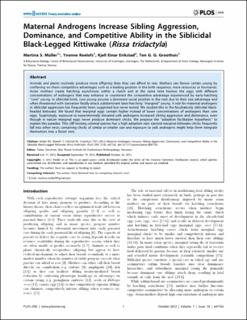Maternal Androgens Increase Sibling Aggression, Dominance, and Competitive Ability in the Siblicidal Black-Legged Kittiwake (Rissa tridactyla)
Peer reviewed, Journal article
Published version

Åpne
Permanent lenke
https://hdl.handle.net/11250/3076636Utgivelsesdato
2012Metadata
Vis full innførselSamlinger
- Publikasjoner fra CRIStin - NINA [2364]
- Scientific publications [1392]
Originalversjon
10.1371/journal.pone.0047763Sammendrag
Animals and plants routinely produce more offspring than they can afford to rear. Mothers can favour certain young by conferring on them competitive advantages such as a leading position in the birth sequence, more resources or hormones. Avian mothers create hatching asynchrony within a clutch and at the same time bestow the eggs with different concentrations of androgens that may enhance or counteract the competitive advantage experienced by early-hatching ‘‘core’’ young. In siblicidal birds, core young assume a dominant social position in the nest due to their size advantage and when threatened with starvation fatally attack subdominant later-hatching ‘‘marginal’’ young. A role for maternal androgens in siblicidal aggression has frequently been suggested but never tested. We studied this in the facultatively siblicidal blackheaded kittiwake. We found that marginal eggs contain higher instead of lower concentrations of androgens than core eggs. Surprisingly, exposure to experimentally elevated yolk androgens increased sibling aggression and dominance, even though in nature marginal eggs never produce dominant chicks. We propose the ‘‘adoption facilitation hypothesis’’ to explain this paradox. This cliff-nesting colonial species has a high adoption rate: ejected marginal kittiwake chicks frequently fall into other nests containing chicks of similar or smaller size and exposure to yolk androgens might help them integrate themselves into a foster nest. Maternal Androgens Increase Sibling Aggression, Dominance, and Competitive Ability in the Siblicidal Black-Legged Kittiwake (Rissa tridactyla)
